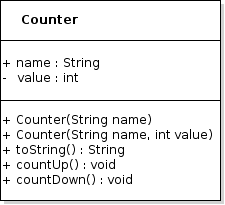
You have 90 minutes to complete this test.
This is a closed
book test (you may use resources linked below).
Follow the instructions below carefully!!
For each of the following questions, open the relevant java file in Eclipse, and complete the program/method(s) as per the given instructions below. As you complete each, do a submit (remember repeated submits will just overwrite older submissions - be sure to submit regularly)
You should aim to allocate 25-30 minutes per question
In
BirthDate.java
, read the comments at the beginning of this file to have an idea of
the expected behaviour of the application. Then complete the main method,
by inserting code where necessary to achieve the expected behaviours.
You will need to make use of services in the
String
and
Integer
classes primarily, the API's of which can be found through the Java API
link at the top of this page. The relevant packages are:
java.lang.String
and
java.lang.Integer
, while exception API's can be found in
java.lang.Exception
Please refer to the comments in the file that indicate expected behaviour and output for the app overall and for each task.
Note: there is no tester provided for Q1 (this may/may not be provided in actual test)
In
Counter.java
you are required to complete the implementation of the basic components
of the
Counter
class, as specified in the following UML diagram. The
Counter
class stores an integer value (that keeps track of a count of things),
and a String name (the name of the Counter).
The class can be instantiated, and supports some limited functionality (an accessor that returns a String version of the Counter's state, and two mutators that modify the counter's value). The class consists of 2 fields, 2 constructors, 1 accessor, and 2 mutator methods only (do not create more features than this).
A detailed description of each of these class components is given in the following Counter API. Click on the name of each method in the Counter API to jump to its detailed description.
Your task is to complete the implementation of Counter as specified, by completing the code in Counter.java.
NOTE: the second custom constructor requires you to generate an exception if a particular condition is satisfied.

To test your Counter class, run the file
Tester.java
(without any modification). This may/may not be provided in the actual test (however it gives you an idea of how the class will be evaluated)
Please type your answers into the file answers.txt.
What keyword is used to explicitly raise an exception? a) catch b) throw c) throws d) raise e) try f) throwable
Which of the following classes relates to the set of exceptions that may be caught in a catch block? a) Error b) Exception c) RuntimeException d) All of the above
Given the following code fragment:
String[] myWords = { "hello", "adieu", "ciao", "guten tag" };
String currWord = myWords[10];
System.out.println(currWord);
The most likely exception to be thrown would be:
a) NullPointerException
b) ArrayIndexOutOfBoundsException
c) StringIndexOutOfBoundsException
d) ArithmeticException
e) No exceptions would be thrown
A default constructor for a class A must: a) always be public if a client wishes to instantiate objects of class A b) always be private if a client wishes to instantiate objects of class A securely c) always be protected, so that clients can only instantiate valid objects of class A d) can never be private e) can never be public
If a class variable is declared as public, then: a) this means that an object of this class can now be instantiated by an external client b) the field associated with that class variable can be modified directly by a client c) the class variable can legally be used to represent an object of another class d) a client can only access the class variable via public methods defined for that class
If class A is a composition of class B, which of the following statements is most accurate? a) An object of class B "is associated" with an object of class A, however the B object may exist independently from the A object b) An object of class B is a specialized "version" of a class A object, and assumes all attributes and fields from the class A c) The object of class B "belongs to" an object of class A, such that the B object may only exist as a part of an A object d) none of the above
What does the keyword "static" mean in the context of a class field [2 marks]?
Briefly explain what is meant by the term "API" - how does this relate to class features [2 marks]?
DO NOT NEED TO SUBMIT - THIS IS A PRACTICE TEST ONLY!
you may practice submission here (submit to ptest1a) to check you are not submitting empty files